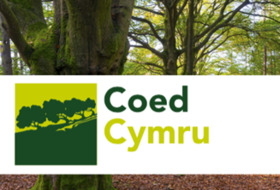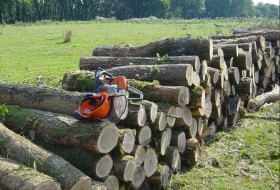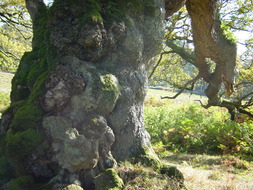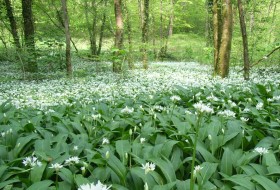Woodlands
Page updated on: 14/11/2023
Woodlands and forests cover about one-seventh of Carmarthenshire. Pick one and you will usually find that it falls into one of two quite separate groups. These two types of woodland have different types of tree, different uses and different histories.
Plantations of introduced conifers (and occasionally non-native broadleaves like red oak) make up about 70% of the total area. Most of these woodlands have been planted since 1940. They cover large areas in the uplands, have replaced native woodlands along some valley sides and have been planted on reclaimed industrial land.
More than half of the trees are Sitka spruce. The rest include Norway spruce (the traditional Christmas tree), larches, pines and Douglas fir. More than half are owned and managed by Natural Resources Wales on behalf of the Welsh Government.
Native woodlands make up the remaining 30% of our woodlands. They are scattered throughout the Welsh countryside, often on land that was too difficult or too poor to clear for agriculture. Many are the remnants of the native, broadleaved woodland that once covered much of Wales. Oak is the commonest tree, with ash, beech, sycamore, birch and alder making up most of the rest. Yew, the only conifer native to Carmarthenshire, is found wild in a few woodlands. Most native woodlands are privately owned, many by farmers. They are often small, covering just a few hectares. In the past many were managed for a wide range of products.
Woodlands and forests are also valuable places for recreation and education and are an important part of the Carmarthenshire landscape. They generate employment and, by absorbing and storing carbon dioxide, play their part in fighting climate change.
Coniferous and broadleaved woodlands have traditionally been managed in different ways. Conifer forests have usually been planted, left to grow for between 40 and 60 years, clear felled and then replanted. The huge expansion of this type of woodland during the 20th Century followed timber shortages during the two World Wars.
Today most coniferous timber (often called softwood) is used to manufacture chipboard, paper and cardboard and by local businesses producing sawn timber, fencing and other products. Although originally established to grow timber many of these forests are now managed for recreation and wildlife too.
Our native broadleaved woodlands were an important part of the local economy for hundreds of years. They provided timber for building, materials for craftspeople, charcoal for smelting, oak bark for tanning, firewood and much more. Most have now lost that role and often have been unmanaged for many years.
Many were felled during the first half of the 20th Century, then cleared for agriculture, replanted with conifers or left to regrow unmanaged from stumps or seed. Since the 1980s initiatives such as Coed Cymru and a range of grants from Forestry Commission Wales (now part of Natural Resources Wales) have encouraged many woodland owners to managing their native woodlands. Some of the woodlands felled and planted with conifers in the last century are now being restored as native woodland.
Managing a woodland can benefit biodiversity. Thinning will produce bigger trees more quickly, help to manage the variety of tree species and let in light to encourage woodland plants and young trees. Coppicing will open up temporary glades in the woodland and encourage birds, butterflies and other wildlife. Management needs to be carefully controlled. New track routes need to be cut where they will do the least damage. Old, dead and dying trees, vital for woodpeckers, beetles and other woodland wildlife need to be kept wherever possible.
The best woodland for biodiversity is often one with a bit of everything – trees of all ages from seedling to veteran, plenty of different species, damp areas, dark areas, sunny areas, grasses, brambles, spring flowers, dry banks, stony banks, mossy banks.
The Glastir Woodland Management scheme provides grants for managing woodlands.
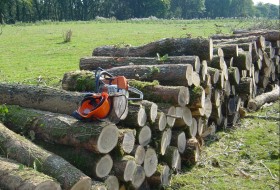
The amount of woodland in Carmarthenshire is gradually increasing as people plant new areas, mostly with native trees. Left to itself, land taken out of agricultural production may also become woodland. Trees and shrubs such as birch, willow, blackthorn, hawthorn and gorse will often appear first. It may take many decades before you see real woodland but the scrubby stage in between can be a rich wildlife habitat. New woodlands that link up and expand existing native woodlands are especially important.
Grants for planting new woodlands are provided by the Glastir Woodland Creation scheme.
Oak responds very well to thinning and will develop and build a crown if other trees do not crowd it. Both species begin to yield seed between the ages of 35-50, and oak coppice shoots can produce acorns 20 years after the stools are cut. Most prolific seeding occurs when the trees are 80-120 years old depending on site and climatic conditions. Seed is not produced prolifically every year, rather at intervals of 3-4 years for pedunculate oak, and 4-5 years for sessile oak. These seed years are termed 'mast' years, and seed produced between mast years is often poor, or absent altogether.
Ash, like the oak, is frost tender and light demanding. It regenerates prolifically, coppices freely and grows well in mixtures with oak, beech and sycamore. Ash grows quickly as a young tree with the growth peaking at age 20-25 years, stabilising at 40-45 and slowing to a minimum at 60 years and beyond. Seed production follows a similar pattern, with the first good crop of winged ash 'keys' coming at age 25-30 reaching a maximum at 40-60 years. The production of keys is not cyclical and good seed is produced in most years. Ash seedlings can withstand moderate shade but the growing tree is light demanding requiring overhead light and side shelter. Unlike oak it will not respond well to thinning if the crown has been restricted by competition. Ash is susceptible to frost damage, which causes forking in the mature tree and bacterial cancer which leads to degradation of the stem. In 2012 the ash disease Chalara fraxinea was found on recently planted ash trees near Carmarthen. This fungal infection has now been found on mature trees near Ferryside. It is likely that this disease will eventually infect many of our ash trees.
Birch is slower growing and appears more suited to the poorly drained peaty soils of the Welsh uplands. Birch is extremely frost-hardy and tolerant of exposure. It acts as a soil improver and the leaf litter reduces soil acidity. Young trees coppice freely and will usually recover from fire damage by producing new basal shoots. Young trees are vulnerable to browsing damage by farm stock, deer and small mammals. Birch produces large quantities of seed from a young age. It is light and airborne which enables it to colonise bare sites readily but it struggles to compete with existing ground vegetation except heather. Birch is a fast growing, short lived species, growing rapidly for the first 20 years reaching maturity at 40-50 years and slowing to death at 60-80 years. Areas of pure birch have the tendency to self-thin and do not respond well to thinning operations after canopy closure.
Beech is often associated with alkaline soils, but it will tolerate a wide range of soils and sites. It regenerates freely under the canopies of other trees and is often found in dense groups growing very slowly in extremes of light and nutrient competition. Seeding is also poor under a closed canopy, with little seed produced before the tree is 60 years old, sooner in an open grown tree. Production of seed reaches a maximum at age 80-140 and seeding may continue until the tree is 200 years of age. Mast years occur at irregular 5-15 year intervals and are believed to be associated with warm dry summers. Because of its need for the shelter of other trees and frost tenderness beech is not an ideal species for planting on open ground. It is better as an understory crop. It responds well to thinning, providing the crowns are big enough to recover. Young beech tends to hold its leaves during the winter which along with its shade bearing qualities and ability to withstand exposure make it ideally suited to shelter belts and windbreaks. Planting of beech in large quantities is not recommended as it suffers from a variety of fungal and bacterial diseases. It is often attacked by grey squirrels which strip the bark, causing serious timber defects and opening wounds for invasion of bacteria and fungi.
Sycamore will survive on most soil types but prefers deep well drained soils over chalk or limestone or acid brown earth. It is moderately susceptible to frost damage. Sycamore coppices well and regenerates freely, growing rapidly in the first 25 years of its life. It is often found in mixture with wild cherry, beech and ash or as a single species. Sycamore responds well to regular thinning to keep the crown deep and the growth vigorous. It is longer lived than other maples reaching maturity at 75+ years and can live well into its 100's. Grey squirrels will strip the bark and damage to the tree and timber can be significant if uncontrolled. The invasive nature of the regeneration can stifle the growth of other saplings particularly oak, and mature trees cast heavy shade which suppresses ground flora. It should not be introduced into native broadleaf woods where it is not already present.
Alder is a useful nurse to oak on heavy soil, coppices well, is hardy to frost and is deep rooting and wind firm. These characteristics make is a useful tree in shelter belts particularly as it is not that palatable to grazing animals.
Alder seedlings require moisture to establish, so regeneration is only successful in areas that remain damp through the spring and summer months. Growth is rapid for the first 20 years with maturity reached at 30-40 years. Growth is negligible at 60 years and above. Planted alder also does well on drier sites.
Wild cherry regenerates in the wild from seed and from suckering from parent trees. It grows rapidly on weed-free open sites to reach maturity in 55-65 years. Cherry sometimes dies for no apparent reason, followed by decay of the timber. Trees should therefore be kept vigorous by regular thinning carried out during the summer to minimise the chances of disease.
Planning
Planning Application Guide
- Development Idea
- Do I need a Planning Agent?
- Key Information
- Pre-Application Stage
- Types of Planning Application
- Application submission
- Validation
- Live Application
- Planning Committee
- Appeals
- Compliance / Enforcement
- Completion of Development
Major Planning Applications
Extending / changing your home
- Lawful Development Certificate
- Pre-application advice service
- Householder planning permission
- Neighbouring properties / party walls
- Bats and nesting birds
- Conservation areas
- Listed buildings
Search for a Planning Application
Breach of planning
Change of Use (Planning)
Pre-application consultation (PAC)
Highways planning liaison
Development Viability Model (DVM) Assessment Tool
Sustainable Drainage Systems (SuDS)
Apply for Section 106 funds
Local Development Order (LDO)
Listed Buildings and Conservation Areas
- Understanding listing
- When is listed building consent required?
- Alterations to Listed Buildings
- Applying for listed building consent
- What happens after a decision on listed building consent has been made?
- Works to a listed building without consent
- Maintenance and Repair
- Further sources of information
- Conservation Areas
Conservation & countryside
Street naming and numbering
My Nearest - Planning information
Planning Policy
- Local Development Plan 2006 - 2021
- LDP Review Report
- Supplementary Planning Guidance (SPG)
- Affordable Housing
- Affordable Housing areas
- Annual Monitoring Report (AMR)
- Housing Land Supply
- Community Infrastructure Levy (CIL)
Local Development Plan 2018 - 2033
- Integrated Sustainability Appraisal and Habitats Regulations Assessment
- Delivery Agreement
- Candidate Sites
- Inspector’s Report and Adoption
- Submission and Independent Examination
- Second Deposit Revised Local Development Plan
- Preferred Strategy (Pre-Deposit Public Consultation)
- Development of an evidence base
- Frequently asked questions
- First Deposit Revised LDP
Renewable Energy
Planning Ecology
New phosphates targets
- What action have we taken?
- West Wales Calculator
- Mitigation Measures
- Next Steps
- Phosphates - Frequently Asked Questions
- Teifi Demonstrator Catchment Project
Biodiversity
- Why biodiversity matters?
- Priority Species in Carmarthenshire
- Priority Habitats in Carmarthenshire
- Carmarthenshire Nature Partnership
- HLF Bogs project
- Marsh fritillary project
- Hedgerows
- Woodlands
- Pollinators
- Get out and about!
- Legislation and Guidance
- Protected sites
- Ash dieback disease
- Wildlife in your Ward
- Local Places for Nature
Waste
More from Planning


